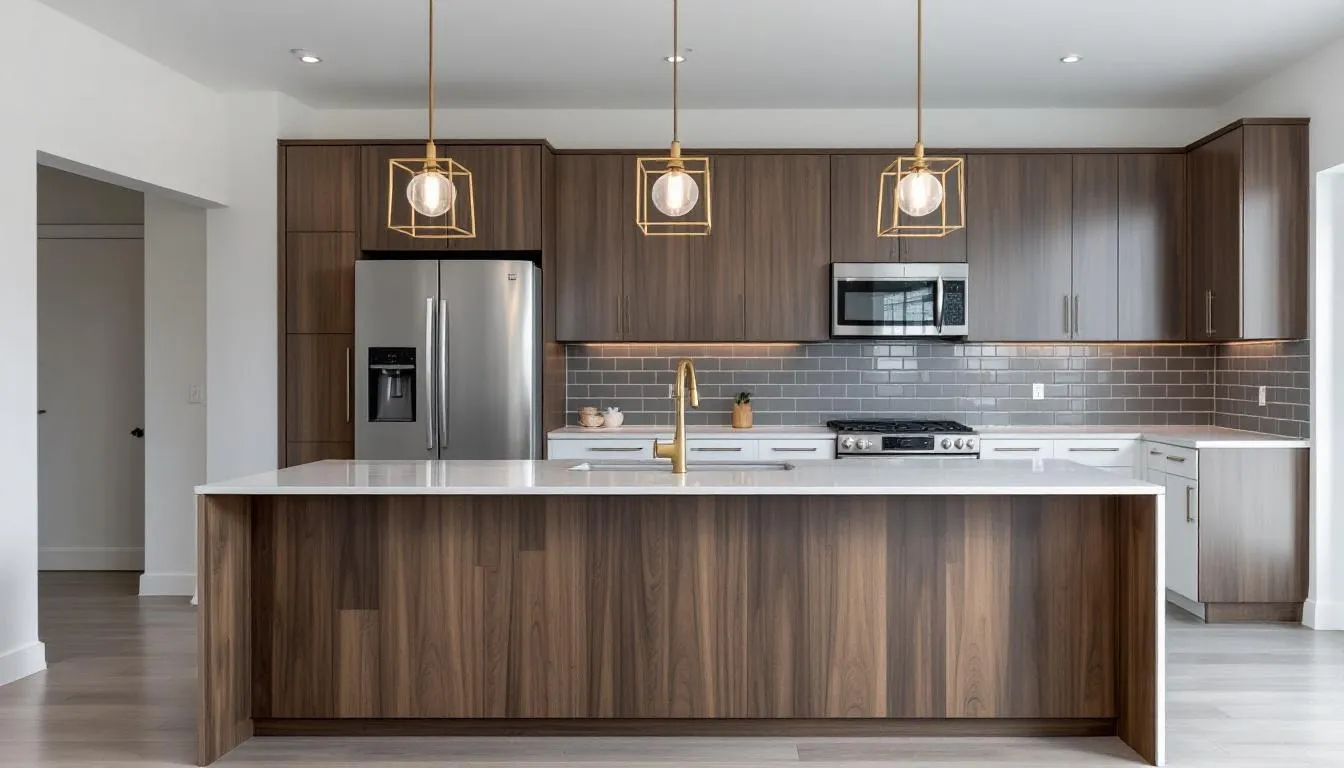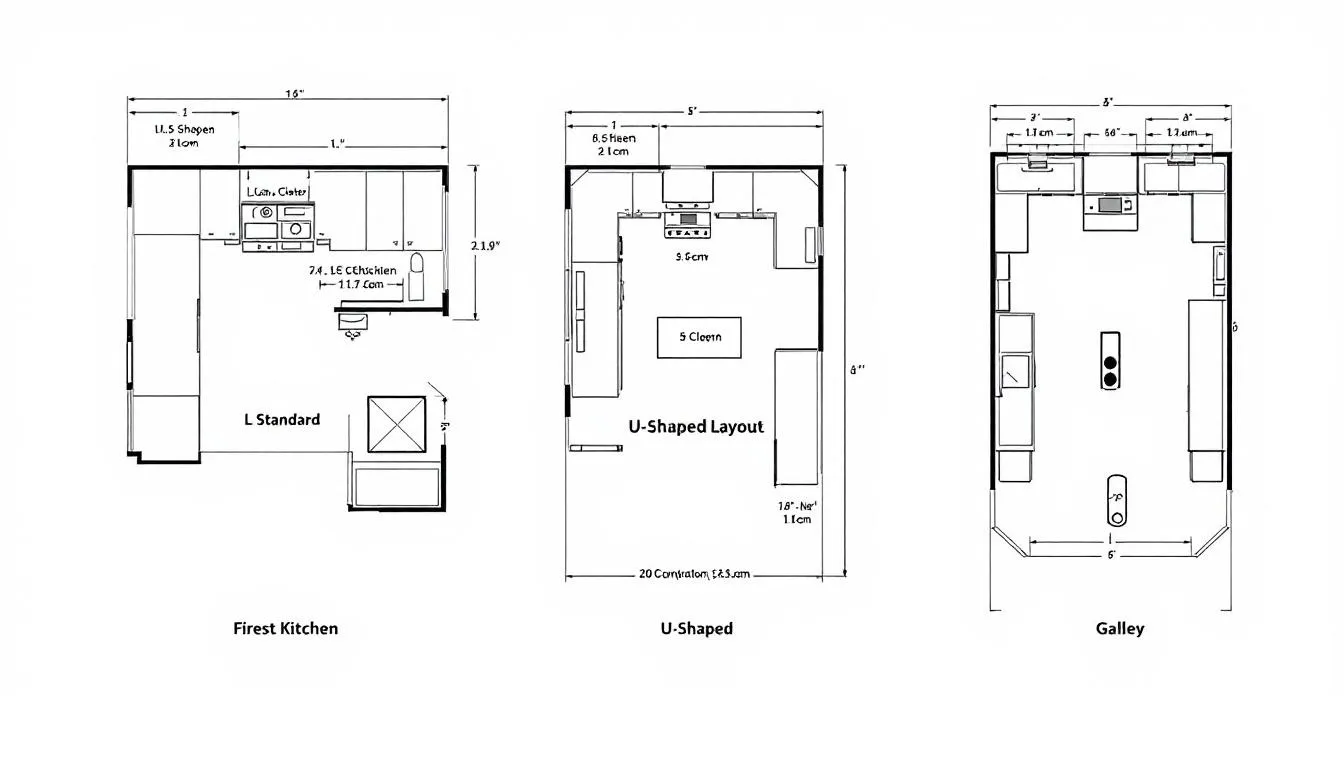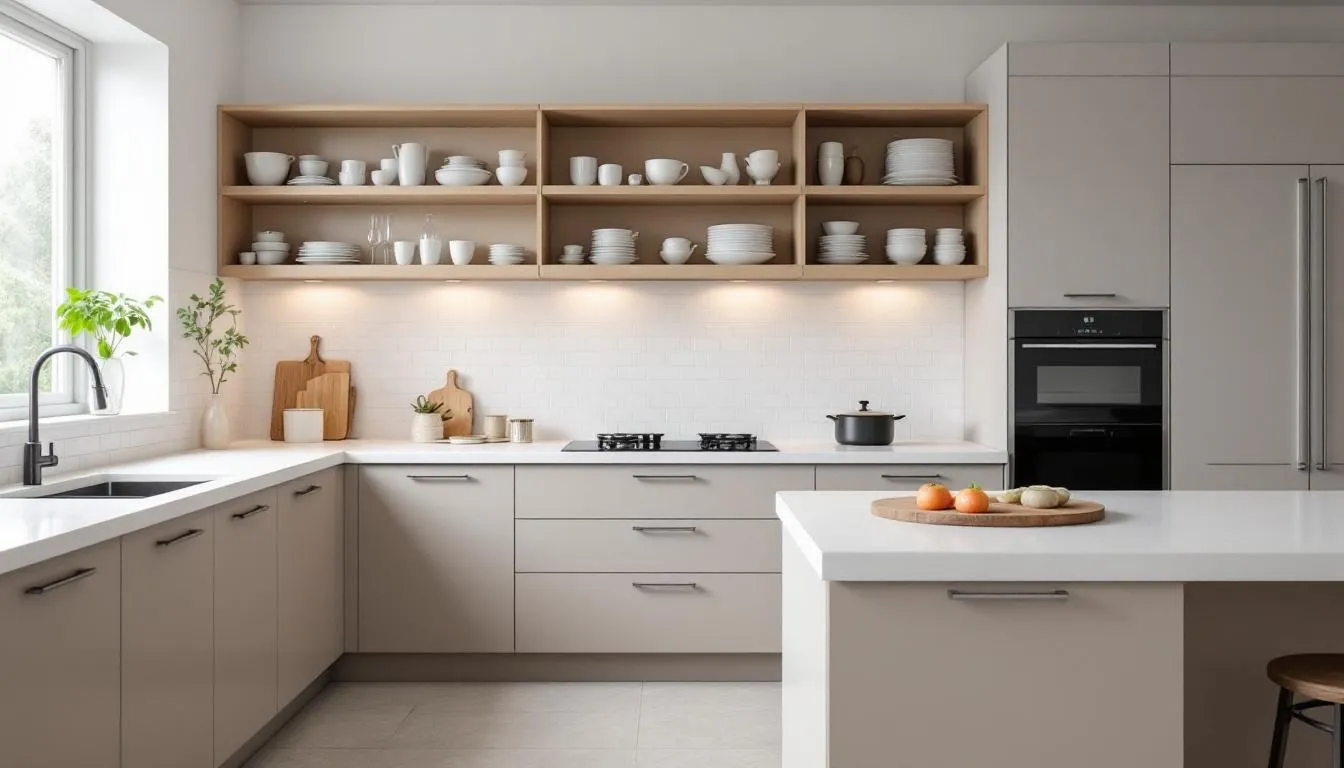Kitchen remodeling represents one of the most popular and valuable home improvement projects for good reason. As the heart of the home where families gather to prepare food, share meals, and create memories, the kitchen deserves careful planning and thoughtful design. Whether you’re dreaming of a modern kitchen with smart appliances or simply need more counter space and storage, a successful kitchen remodel can transform both your daily routine and your home’s value.
This comprehensive guide will walk you through every aspect of kitchen remodeling projects, from initial planning and budgeting to selecting materials and managing the construction process. You’ll learn how to avoid common pitfalls, maximize your investment, and create the dream kitchen that perfectly suits your lifestyle and cooking habits.
Getting Started with Your Kitchen Remodel
Kitchen remodeling costs average $26,934 but range from $14,600 to $41,485 depending on scope and materials selected. These remodeling projects typically require 8.3 months of planning and 4.5 months of construction, making thorough preparation essential for success.
Before diving into design ideas, assess your current kitchen’s problems. Common issues include poor lighting that makes food preparation difficult, limited storage that leaves countertops cluttered, inefficient layouts that create bottlenecks during cooking, and outdated appliances that waste energy and space. Understanding these pain points helps prioritize improvements and allocate your budget effectively.
The popularity of kitchen renovation stems from both functional needs and lifestyle changes. Modern families spend more time in the kitchen, whether preparing meals, working from home, or entertaining guests. Open-plan layouts have made kitchens more visible to the rest of the house, increasing the importance of attractive design alongside functionality.

Planning Your Kitchen Renovation Project
Create a detailed plan covering budget, design goals, and must-have features before starting any work. This clear plan prevents costly changes mid-project and ensures all team members understand the vision. Start by listing your priorities: Do you need more storage, better workflow, updated appliances, or simply a fresh aesthetic?
Measure your current kitchen layout including doors, windows, and immovable plumbing fixtures. These measurements become the foundation for design work and help contractors provide accurate estimates. Note the locations of gas lines, electrical outlets, and water supply lines, as moving these increases costs significantly.
Set aside 20% of total budget for unexpected expenses and delays. Kitchen remodels frequently reveal hidden problems like water damage, outdated wiring, or structural issues that require immediate attention. This contingency fund prevents project delays and reduces stress when surprises arise.
Use online design tools and consult with kitchen design companies for professional guidance. Many homeowners benefit from working with a kitchen designer who can optimize layouts, suggest space-saving solutions, and help navigate the overwhelming array of material choices available today.
Setting a Realistic Budget
Break down budget into categories to ensure comprehensive planning. Cabinetry often represents the most expensive part of kitchen remodels, typically accounting for 25-30% of total costs. Countertops consume 10-15% of budgets, while appliances require 15-20% and labor costs can reach 20-35% depending on project complexity.
Research and compare contractor quotes early in planning process. Contact multiple general contractors to understand pricing in your area and identify red flags like unusually low or high estimates. Quality contractors provide detailed breakdowns and can explain cost variations between different approaches.
Consider cost-effective alternatives like cabinet refacing instead of full replacement. If your current kitchen cabinets are structurally sound, refacing with new doors and drawer fronts costs significantly less than complete replacement while still achieving a fresh look. Similarly, painting existing cabinets offers dramatic transformation at minimal cost.
Include smaller items like cabinet hardware, light fixtures, and paint in your budget calculations. These finishing touches often cost more than expected but significantly impact the final appearance. Quality cabinet hardware alone can cost several hundred dollars, while proper lighting fixtures may require thousands depending on your choices.
Choosing the Right Kitchen Layout and Design
Popular layouts include U-shape, L-shape, galley layout, island, and peninsula configurations, each offering distinct advantages depending on your space and cooking habits. The galley layout works well in tight spaces, providing efficient workflow between parallel counters. L-shaped kitchens maximize space utilization in corner locations, while U-shaped designs offer abundant counter space and storage for serious cooks.
Keeping existing layout saves money significantly, as moving walls and plumbing increases costs substantially. Moving plumbing requires permits, professional installation, and often affects multiple rooms. Electrical work becomes more complex when relocating major appliances, particularly if upgrading to higher-powered units requiring new circuits.
Design based on cooking habits rather than trends. Families focused on entertaining benefit from open layouts with large islands for gathering, while serious cooks prefer closed kitchens that contain noise and odors. Consider how you actually use your kitchen: Do you prepare elaborate meals requiring extensive prep space, or do you primarily reheat and assemble simple dishes?
The work triangle concept remains relevant for efficient kitchen design, connecting the sink, stove, and refrigerator in a logical pattern that minimizes steps during food preparation. However, modern kitchens often include multiple work zones for different activities, such as coffee stations, baking areas, or homework zones that require careful integration.

Kitchen Workflow and Clearance Requirements
Maintain 36-inch walkways for single person navigation, with 42-48 inches in cooking zones where multiple cooks work simultaneously. These clearances prevent accidents and allow cabinet doors and appliances to open without interference. Consider how traffic flows through your kitchen, especially in open-plan homes where the kitchen connects to living areas.
Allow 15 inches of counter space on both sides of cooktops and refrigerators for safe operation and food preparation. This spacing provides room for hot pots, ingredient staging, and appliance doors to open fully. Plan for larger clearances around kitchen islands to accommodate multiple people and ensure comfortable movement.
Plan 24 inches of counter space on one side of sink, 18 inches on other side for efficient cleanup and food preparation. The sink area handles the heaviest workflow in most kitchens, requiring adequate space for dish drying, food washing, and waste management. Consider installing pullout storage beneath the sink for cleaning supplies and waste bins.
Organize storage based on usage patterns: breakfast items near dining table, dishes near dishwasher, and cooking utensils near the stove. This approach minimizes steps during daily routines and keeps frequently used items easily accessible. Store heavy items in lower cabinets and keep dangerous items away from areas where children might reach them.
Selecting Kitchen Materials and Finishes
Cabinetry represents largest expense in most kitchen remodels, making cabinet selection crucial for both budget and aesthetics. Stock cabinets offer the most cost-effective option with standard sizes and finishes, while semi-custom cabinets provide more flexibility in sizing and features. Custom cabinets deliver personalized storage solutions and unique designs but require the largest investment and longest lead times.
Consider cabinet refacing, painting, or hardware updates as budget-friendly alternatives to complete replacement. If your current kitchen cabinets are structurally sound with good bones, these approaches can dramatically transform appearance while preserving functionality. New cabinet hardware alone can modernize older kitchens, while professional painting provides fresh color at reasonable cost.
Cabinet materials range from solid wood for traditional appeal to engineered materials for consistent quality and lower cost. Solid wood cabinets offer natural beauty and can be refinished multiple times, but require more maintenance and cost significantly more. Plywood construction provides strength and moisture resistance, while particleboard keeps costs down but offers less durability.
Modern cabinet features include soft-close hinges, pullout storage systems, and integrated organizers that maximize space efficiency. Deep drawers accommodate large pots and pans better than traditional shelves, while lazy Susans make corner cabinets more accessible. Consider your specific storage needs when selecting cabinet configurations and accessories.
Countertops and Backsplash Selection
Quartz countertops offer low maintenance and durability while granite provides luxury appeal with natural stone beauty. Quartz surfaces resist stains and scratches without requiring regular sealing, making them ideal for busy kitchens. Granite offers unique patterns and colors but requires periodic sealing and more careful maintenance to prevent damage.
Consider budget-friendly alternatives like laminate or tile instead of premium stone surfaces. Modern laminates convincingly mimic natural materials while offering easy maintenance and affordable pricing. Large-format porcelain tiles provide stone-like appearance with superior durability and easier installation than natural materials.
Choose materials balancing durability, maintenance requirements, and visual appeal for long-term satisfaction. High-use areas like islands benefit from durable materials that withstand daily wear, while less-used sections might accommodate more delicate finishes. Consider how different materials age and whether they can be repaired if damaged.
Select colors and patterns that complement overall kitchen aesthetic without dating quickly. Neutral colors like white, gray, and beige provide timeless appeal and work with changing décor, while bold patterns may feel outdated sooner. Natural materials often age more gracefully than synthetic alternatives designed to mimic current trends.

Kitchen Appliance Considerations
Choose Energy Star-rated appliances to reduce energy bills and environmental impact while often qualifying for utility rebates. Modern refrigerators, dishwashers, and ovens use significantly less energy than older models, providing long-term savings that offset higher initial costs. Smart appliances offer convenience features like remote monitoring and programmable settings.
Modern features include convection ovens for faster cooking, multi-level dishwashers for improved organization, and induction cooktops for precise temperature control. These technologies improve cooking results while often reducing energy consumption. Consider which features align with your cooking style and frequency of use.
Select new appliances matching cooking habits and lifestyle needs rather than impressive features you’ll rarely use. Serious bakers benefit from convection ovens and stand mixers, while busy families might prioritize quick-cooking features and easy cleanup. Avoid over-buying expensive appliances that exceed your actual requirements.
Plan appliance placement carefully to avoid door interference and ensure proper clearances for ventilation and service access. Refrigerators need several inches of clearance on sides and back for proper airflow, while ranges require adequate ventilation and clearance from combustible materials. Consider how appliance doors swing and whether they’ll interfere with workflow or other appliances.
Hiring Kitchen Remodeling Contractors
Research contractors thoroughly, checking licenses, insurance, and recent client references before making hiring decisions. Verify that contractors carry both general liability and workers’ compensation insurance to protect yourself from potential liability. Contact recent clients to ask about work quality, communication, timeline adherence, and overall satisfaction.
Request detailed contracts before starting work and avoid large upfront payments that exceed 10% of total project cost. Quality contractors typically request payment schedules tied to project milestones rather than large advance payments. Contracts should specify materials, timelines, change order procedures, and warranty terms to prevent misunderstandings.
Evaluate communication style, project management approach, and experience with similar remodeling projects during initial meetings. Contractors should answer questions clearly, provide detailed proposals, and demonstrate organization in their business practices. Experience with kitchen remodels specifically matters more than general construction experience due to specialized requirements.
Warning signs include door-to-door solicitation, requests for full payment upfront, lack of local references, or significantly lower bids without clear explanation. Quality work requires fair compensation, so extremely low bids often indicate corner-cutting or hidden costs that emerge later. Trust your instincts about contractors’ professionalism and communication abilities.
Managing Your Remodeling Timeline
Typical phases include demolition, structural work, electrical and plumbing work, drywall installation, and final installations of cabinets, countertops, and appliances. Each phase must complete before the next begins, making scheduling coordination crucial for avoiding delays. Weather, permit approvals, and material deliveries can all impact timelines.
Coordinate tasks carefully: electrical work and plumbing must complete before drywall installation, while new flooring typically installs before cabinets to ensure proper fit and finish. Some materials require specific installation sequences, such as hardwood floors that need acclimation time or tile work that requires curing periods.
Build flexibility into timeline for delays due to permits, supply chain issues, or unexpected problems discovered during demolition. Custom cabinets may require 4-8 weeks for manufacture and delivery, while appliance availability can vary significantly. Plan for these lead times early in the process to avoid project delays.
Maintain regular communication with your general contractor to address issues quickly and keep projects moving smoothly. Weekly progress meetings help identify potential problems before they become major delays. Document changes and decisions in writing to prevent misunderstandings later in the process.
Maximizing Storage and Functionality
Plan storage based on kitchen use patterns and accessibility needs to create truly functional space. Store frequently used items in easy-reach locations while placing occasional-use items in higher or lower cabinets. Consider the height and mobility of all family members when planning storage locations and access methods.
Include features like pullout storage, lazy Susans, and pantry organization systems to make every inch of cabinet space functional. Deep drawers work better than shelves for storing pots, pans, and small appliances that you need to access frequently. Vertical dividers help organize cookie sheets, cutting boards, and serving platters efficiently.
Consider toe-kick drawers and tall cabinets for maximizing vertical space that might otherwise go unused. Toe-kick drawers provide storage for flat items like baking sheets, while floor-to-ceiling cabinets offer abundant storage for items you use less frequently. Crown molding can hide gaps between cabinets and ceilings while providing finished appearance.
Kitchen storage should accommodate changing needs over time, with adjustable shelves and modular systems that adapt to different items. Consider how your storage needs might change as family size fluctuates or cooking habits evolve. Flexible systems provide better long-term value than fixed configurations.

Lighting and Electrical Planning
Layer lighting with task lighting over counters, ambient lighting for general illumination, and accent lighting to highlight architectural features or decorative elements. Under-cabinet lighting illuminates work surfaces while pendant lights over islands provide both task lighting and visual interest. Recessed ceiling lights offer ambient lighting without visual clutter.
Install multiple outlets along backsplashes and kitchen islands for modern appliances and gadgets that require electrical power. Plan for coffee makers, toasters, mixers, and charging stations that need convenient outlet access. Islands should include outlets on both sides to accommodate various uses and prevent extension cord hazards.
Include USB outlets and GFCI outlets near water sources for safety and convenience in modern kitchens. GFCI protection prevents electrical shock near sinks and other water sources, while USB outlets eliminate the need for adapter plugs for phones and tablets. Consider outlets with built-in timers for appliances like coffee makers.
Consider under-cabinet lighting and pendant lights over islands for both function and style. LED lighting offers energy efficiency and long life while providing excellent task lighting. Pendant lights should hang 30-36 inches above islands to provide adequate lighting without interfering with sight lines across the room.
Living Through Your Kitchen Renovation
Create temporary cooking space with microwave, toaster oven, and basic appliances to maintain some meal preparation capability during construction. Set up this temporary kitchen in a nearby room with access to water and electrical outlets. Include basic items like plates, cups, and utensils for simple meals and snacks.
Plan meals around construction phases and consider takeout budget as part of overall project costs. Demolition and appliance installation phases typically require complete kitchen shutdown, while other phases may allow limited use. Research local restaurants and meal delivery services to identify convenient options during peak construction periods.
Protect belongings and maintain dust barriers in rest of home to minimize renovation impact on daily life. Construction generates significant dust and debris that can spread throughout the house without proper containment. Seal doorways with plastic sheeting and run air purifiers to maintain air quality in occupied areas.
Consider staying with family or friends during intensive construction phases if space permits and noise levels become unbearable. Some homeowners find the disruption too stressful and prefer temporary relocation, especially during demolition and major installation work. Factor this potential cost into your overall budget and timeline planning.
A mini fridge and basic prep area can help maintain some normalcy while your main kitchen undergoes transformation. Plastic wrap, paper plates, and disposable utensils reduce cleanup needs when proper washing facilities aren’t available. Plan storage for these temporary items so they don’t interfere with construction work.
Common Kitchen Remodeling Mistakes to Avoid
Don’t prioritize style over function and adequate storage capacity when making design decisions. Beautiful kitchens that don’t work well for daily use quickly become frustrating and may require expensive modifications. Ensure adequate storage for all your items before finalizing cabinet layouts and configurations.
Avoid trendy designs that may become outdated quickly, especially for expensive elements like cabinetry and countertops. Classic styles with timeless appeal maintain their attractiveness longer and provide better resale value. Save trendy elements for easily changeable items like paint colors, lighting fixtures, or cabinet hardware.
Don’t underestimate costs or skip the 20% contingency budget that experienced contractors recommend. Kitchen remodels frequently encounter unexpected expenses like electrical upgrades, plumbing modifications, or structural repairs discovered during demolition. Having financial cushion prevents project delays and reduces stress when issues arise.
Avoid choosing contractors based solely on lowest bid without checking qualifications, references, and insurance coverage. Quality work requires fair compensation, and extremely low bids often indicate problems like unlicensed workers, inferior materials, or hidden costs that emerge later. Invest time in proper contractor research to avoid expensive problems.
Don’t rush the planning phase or make major decisions without adequate research and consideration. Changing your mind after work begins costs significantly more than thorough planning upfront. Take time to research materials, compare options, and visualize the final result before committing to specific choices.
Permits and Building Codes
Electrical work, plumbing modifications, and gas lines typically require permits and inspections to ensure safety and code compliance. Licensed professionals usually handle permit applications and understand local requirements, but homeowners should verify that permits are obtained before work begins. Working without permits can create problems during home sales and insurance claims.
Structural changes like removing walls require engineering approval to ensure that load-bearing elements aren’t compromised. Even seemingly minor changes can affect structural integrity, especially in older homes where previous modifications may have altered original designs. Professional assessment prevents dangerous mistakes and ensures long-term safety.
Licensed professionals usually handle permit applications and ensure code compliance throughout the project. However, homeowners should understand basic requirements and verify that contractors follow proper procedures. Some jurisdictions require homeowner participation in permit applications or allow owner-builder permits for certain work types.
Check local requirements early in planning process to avoid delays and budget for permit costs in your overall project budget. Permit costs vary significantly by location and project scope but typically range from hundreds to thousands of dollars. Processing times also vary, potentially affecting project timelines if not planned properly.
Return on Investment and Home Value
Kitchen remodels typically recoup 60-80% of investment in home resale value, making them among the most valuable home improvement projects. However, return on investment varies significantly based on project scope, quality of materials, and local real estate markets. Minor remodels often provide higher percentage returns than major renovations.
Focus on timeless designs with classic materials for lasting appeal that won’t look outdated in five or ten years. Neutral color schemes, quality materials, and functional layouts appeal to broader range of potential buyers than highly personalized or trendy designs. Balance your personal preferences with broader market appeal.
Over-improving for neighborhood can limit return on investment if your renovation significantly exceeds local standards. Research comparable homes and recent sales to understand appropriate investment levels for your area. A $100,000 kitchen in a $200,000 neighborhood may not provide proportional value increase.
Consider warranties on appliances and systems to protect investment long-term and provide peace of mind. Quality manufacturers offer substantial warranties that demonstrate confidence in their products. Keep warranty documentation organized and understand registration requirements to ensure coverage remains valid.
Modern kitchen features like smart appliances, energy-efficient systems, and quality materials appeal to today’s buyers who value convenience and sustainability. However, avoid overly complex technology that may become obsolete or require expensive maintenance. Focus on features that provide genuine utility and long-term value.
Conclusion
Successful kitchen remodeling requires careful planning, realistic budgeting, and attention to both function and aesthetics. By following this comprehensive guide and avoiding common mistakes, you can create a dream kitchen that enhances your daily life while adding value to your home. Remember that quality planning upfront prevents expensive changes later and ensures your new kitchen serves your family well for years to come.
The key to a successful kitchen remodel lies in balancing your wish list with practical considerations like budget, timeline, and your home’s existing structure. Take time to research options thoroughly, hire qualified professionals, and maintain realistic expectations about costs and timelines. With proper planning and execution, your kitchen renovation can transform not just your space, but your entire home experience.
Start your kitchen remodeling journey today by assessing your current kitchen’s shortcomings and creating a clear plan for improvement. Whether you’re dreaming of a minor update or a complete transformation, the investment in proper planning will pay dividends throughout the entire process and in your long-term satisfaction with the results.
